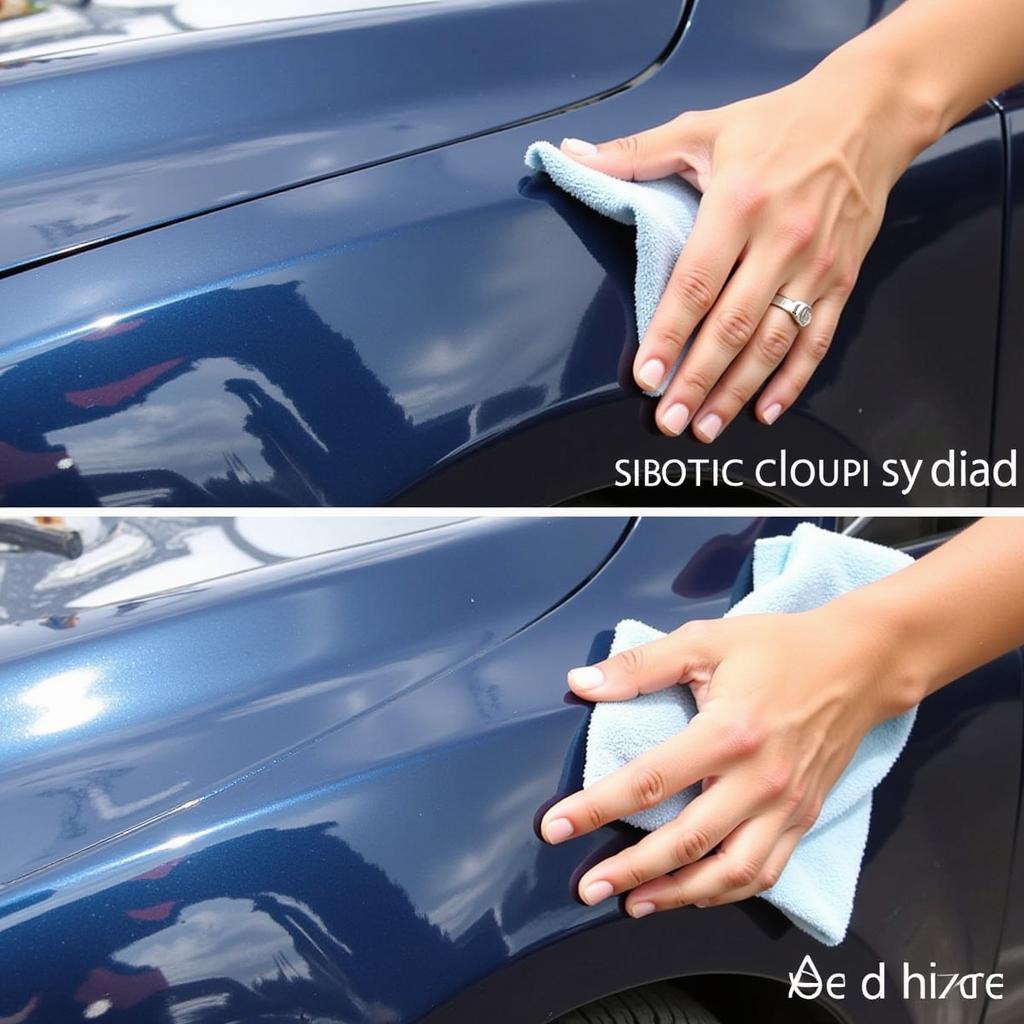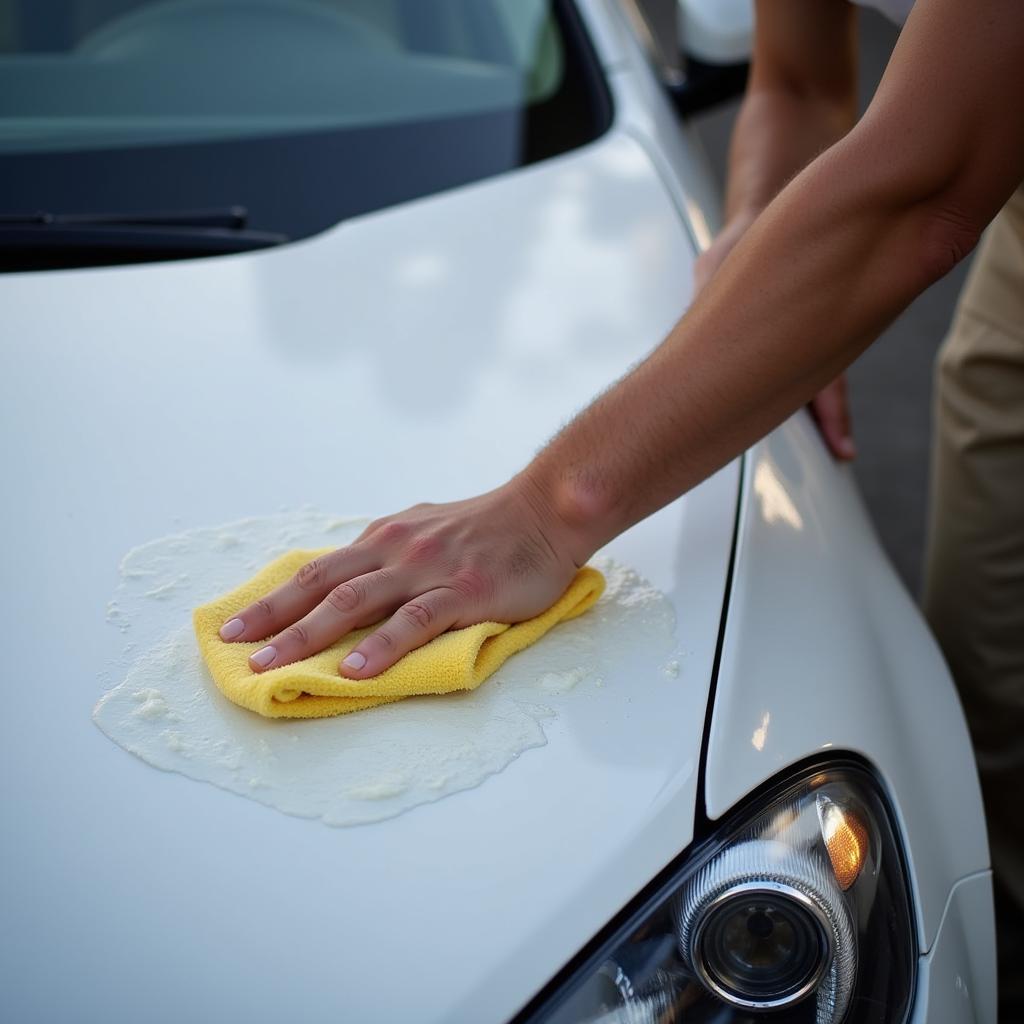Rain can leave your car looking less than its best, with water spots, streaks, and grime taking away from its shine. Knowing how to detail your car after rain is crucial for maintaining its appearance and protecting the paintwork. This guide will walk you through the steps to effectively detail your car after a downpour, bringing back its showroom sparkle.
Why Detailing After Rain is Important
Rainwater isn’t pure. It carries pollutants, minerals, and acids that can etch into your car’s paint, leaving behind unsightly water spots and potentially damaging the clear coat over time. Detailing after rain helps remove these contaminants before they can cause lasting harm. Moreover, rain often washes dirt and grime from other parts of your car onto the paint, creating a muddy film that detracts from its appearance. Addressing this promptly prevents the dirt from becoming ingrained and harder to remove.
A good post-rain detail doesn’t just improve your car’s aesthetics. It also protects it. By removing contaminants and applying protective layers, you’re safeguarding your car’s paint from future damage. If you’re curious about detailing a brand new car, check out why should i detail brand new car.
Essential Tools and Products
Before you begin, gather the following:
- Two buckets (one for wash solution, one for rinsing)
- Car wash soap specifically formulated for automotive paint
- Wash mitts or microfiber wash cloths
- Microfiber drying towels
- Clay bar and lubricant (optional, but highly recommended)
- Car wax or sealant
- Glass cleaner
- Wheel cleaner and brush
- Tire dressing
Step-by-Step Guide to Detailing Your Car After Rain
-
Pre-Rinse: Thoroughly rinse your car with a strong stream of water to remove loose dirt and debris. This is a crucial first step in minimizing swirl marks during the washing process.
-
Wash: Fill one bucket with the car wash solution and the other with clean water. Dip your wash mitt into the soapy water and gently wash the car in sections, starting from the top and working your way down. Rinse the mitt in the clean water bucket after each section to remove dirt and prevent scratching.
-
Clay Bar Treatment (Optional): After washing, a clay bar treatment can remove embedded contaminants that washing alone can’t handle. Lubricate the paint surface and gently glide the clay bar across it. This will lift off any remaining dirt, leaving the paint incredibly smooth. Learn more about this process at what is clay car detailing.
-
Dry: Use a high-quality microfiber drying towel to dry the car completely, working in sections to prevent water spots.
-
Wax or Seal: Apply a layer of car wax or sealant to protect the paint and enhance its shine. Follow the product instructions for proper application and removal.
-
Wheels and Tires: Clean the wheels with a dedicated wheel cleaner and brush. Dress the tires with tire dressing to restore their deep black finish.
-
Glass: Clean the windows and mirrors with a quality glass cleaner and a clean microfiber cloth.
Addressing Water Spots
Water spots are a common issue after rain, especially if the water is allowed to dry on the paint. If you notice water spots after washing, you can try removing them with a dedicated water spot remover or a diluted solution of vinegar and water. For stubborn water spots, polishing may be necessary.
 Removing Water Spots from Car
Removing Water Spots from Car
Professional Detailing Services
If you’re not comfortable detailing your car yourself, or if you’re dealing with particularly stubborn dirt or water spots, consider seeking professional help. Professional detailers have the expertise and tools to restore your car to its pristine condition. Finding a reputable detailer can greatly enhance your car’s appearance and protection. Explore options on where is a good place to get your car detailed or search for where to get a car detailed near me.
Maintaining Your Car’s Shine
Regular washing and waxing are essential for keeping your car looking its best. Consider washing your car every one to two weeks, depending on driving conditions and environmental factors. Waxing every three to six months provides long-lasting protection and shine.
 Applying Car Wax
Applying Car Wax
Conclusion
Detailing your car after rain is a simple yet effective way to maintain its appearance and protect its paintwork. By following these steps and using the right products, you can keep your car looking its best, rain or shine. Remember, regular maintenance is key to preserving your car’s value and ensuring its longevity. If you’re thinking about a career in detailing, find out more on how to become a certified car detailer.
FAQ
-
How often should I detail my car after rain? Ideally, you should wash and dry your car as soon as possible after it rains, especially if the rain was particularly heavy or dirty.
-
Can I use dish soap to wash my car? No, dish soap is too harsh for automotive paint and can strip away its protective wax or sealant.
-
What is the best way to remove water spots? A dedicated water spot remover or a diluted vinegar solution can often remove water spots. For stubborn spots, polishing might be necessary.
-
Is waxing necessary after every wash? No, waxing every three to six months is generally sufficient.
-
How can I prevent water spots from forming? Drying your car immediately after washing is the best way to prevent water spots.
-
What’s the difference between car wax and sealant? Wax provides a deep shine and some protection, while sealant offers longer-lasting protection but less shine.
-
Do I need to detail my car after light rain? A light rinse might be sufficient after light rain, but it’s always a good idea to dry the car completely to prevent spotting.
Need Help?
Contact us via WhatsApp: +1(641)206-8880 or Email: [email protected]. Our 24/7 customer support team is ready to assist you.

Leave a Reply